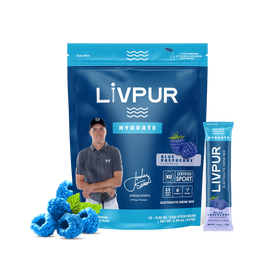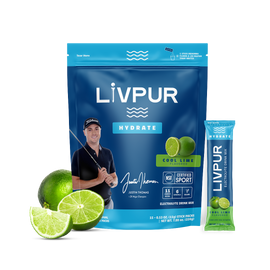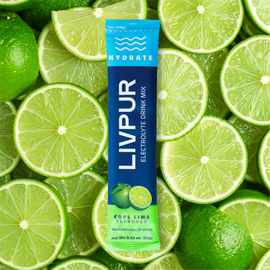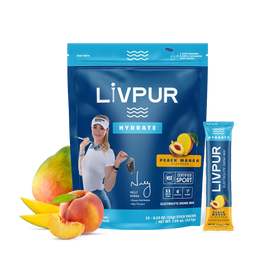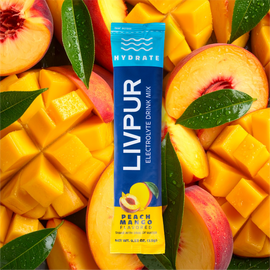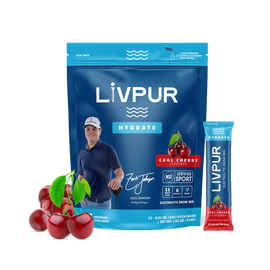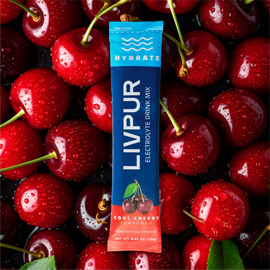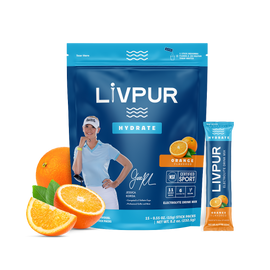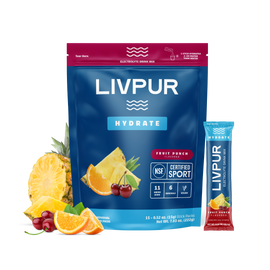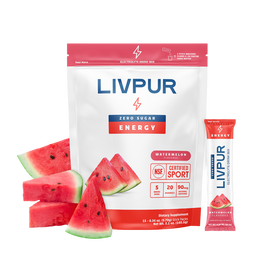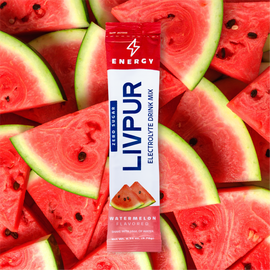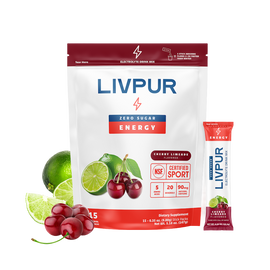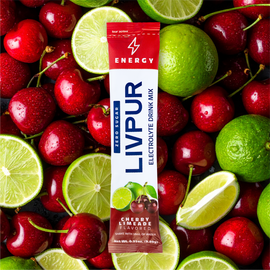August 26, 2025 • By Katie Switow • Blog
Our Best Hydration Tips Before, During, and After Exercise
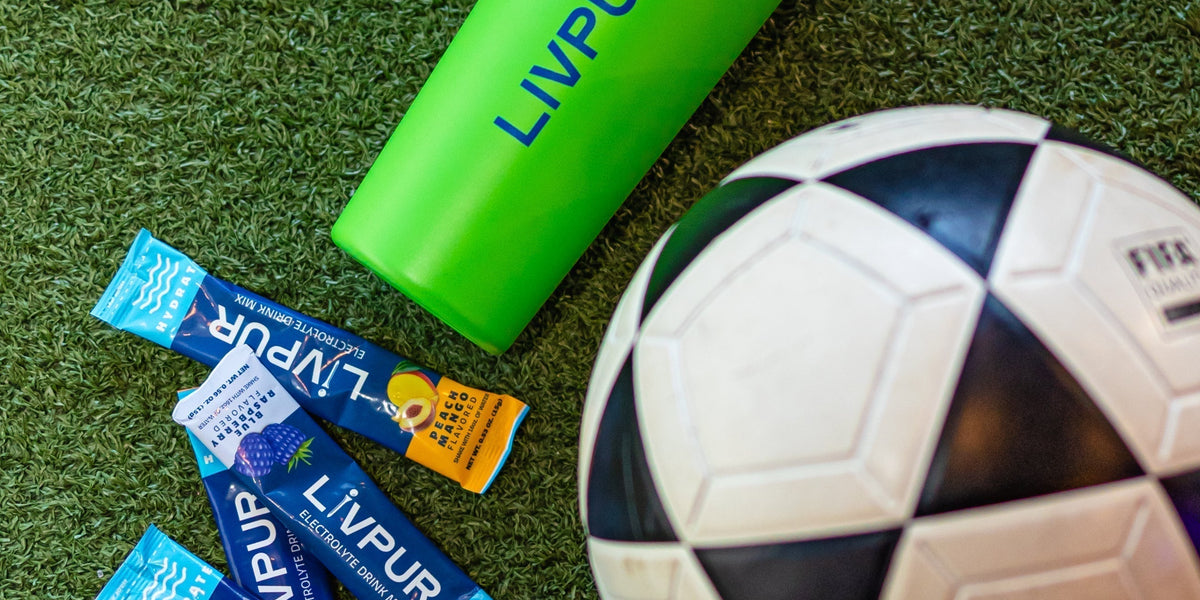
Hydration sets the stage for how well your body performs and how quickly it recovers. We learned that hydration also helps maintain our fluid balance after a workout and regulates our body temperature. So, in our guide to hydration tips before, during, and after exercise, we will walk you through exactly how to prepare before, what to do while you train, and how to recover after. We will finish with a look at two of our own LivPur products that fit into a smart hydration plan. Ready to get hydrated?
What Does Pre-Hydration Mean?

Pre-hydration is the process of consuming fluids and electrolytes before physical activity, competition, or extended exposure to heat. Just like fueling your muscles with the right nutrients, pre-hydrating prepares your body’s cells with the proper balance of water and electrolytes, ensuring you start in an optimal hydration state rather than playing catch-up once dehydration sets in.
The fluids we drink in the hours before training influence how strong we feel when the session begins, which is why we always rehydrate in the morning.
Workouts And Early Water Intake
Think of pre-hydration as arriving ready. We keep a water bottle nearby and drink water steadily throughout the day instead of chugging at the last minute, which can overload the stomach and cut a workout short quickly. A simple pattern works for many people: drink about eight ounces of fluid at a time, taken two or three times in the hours before exercise. Some prefer a single measure, like 16 to 20 ounces of water two hours before a workout, followed by another eight ounces closer to the start. Adjust these amounts to your body size, sweat rate, and comfort.
We've written about a few methods that can help you test your hydration. A simple urine test looking for bright yellow color usually means you’re on track. Dark yellow urine can signal that your body is losing water faster than it’s being replaced. If your days are busy, it can really help to measure all the water you plan to drink in a single large bottle for the day.
Benefits of Pre-Hydration
- Improved Performance: Keeps muscles firing efficiently and prevents early fatigue.
- Better Endurance: Maintains cardiovascular efficiency and temperature regulation.
- Reduced Risk of Cramps: Proper electrolyte intake helps muscles contract and relax smoothly.
- Sharper Focus: Adequate hydration improves concentration, decision-making, and reaction time.
- Faster Recovery: Starting hydrated minimizes stress on the body, aiding in quicker post-activity recovery.
Electrolytes And Sodium Before You Start
Before moving on to the workout itself, think about what’s in your bottle. A little bit of electrolyte mix before your exercise can help your body hold onto fluids, which is especially helpful for heavy sweaters or when you're operating in hot, humid weather.
Sports medicine research often emphasizes sodium, one of the key electrolytes, because it supports fluid balance, maintains hydration, and can lower the chance of cramping in athletes who lose a lot of salt through sweat. If you notice white salt marks on your clothes or skin after training, you may need more sodium. But the other electrolytes are important too, especially if you exercise on a regular basis!
This is a good time to bring in our LivPur Hydrate formula. It offers all the vital electrolytes, including sodium, magnesium, and potassium, as well as amino acids that support fluid movement and energy production. Mixing Hydrate into your pre-workout or morning water provides both hydration and electrolytes to keep you hydrated. For shorter workouts in mild weather, plain water may be enough, but having the right minerals in place before a longer or harder session will make it easier to stay hydrated from start to finish.
Plain Water Vs Sports Drink
Short workouts in mild conditions are fine with plain water. If you expect higher intensity, more sweat, or a longer session, an electrolyte mix or sports drink will cover both fluid and mineral needs. Match the drink to the demands of the session. An easy half-hour weights workout is not the same as an hour of high-intensity intervals, and knowing how much water to take in beforehand can make a difference in athletic performance.
When Should You Pre-Hydrate?

The best time to pre-hydrate is 1–2 hours before exercise, training, or competition. This allows the body to absorb fluids and electrolytes, while giving the kidneys enough time to excrete any excess. A general guideline is to drink 16–20 ounces of water or a hydration solution like LivPur during this window, then sip smaller amounts leading up to the activity.
For morning workouts, pre-hydration is especially crucial since the body often wakes up slightly dehydrated after hours of sleep. For hot or humid conditions, or endurance events, pre-hydration should be more intentional, ensuring your electrolyte balance is primed.
Recovery hydration plays a big role in how quickly your body bounces back. Handling it well now can mean feeling ready to train again sooner.
During Exercise
Once the warm-up is done, hydration becomes a moving target. The goal is to give your body what it needs while still feeling light and able to focus on your pace.
Early Signs Of Dehydration
Watch for early changes in how you feel. Thirst, a slipping pace despite more effort, a light headache, or feeling “off” can all signal dehydration. If you stop and notice dark yellow urine mid-workout, you’re already behind on fluid intake.
Fluid Intake Per Hour
Small, regular sips are better than waiting until you feel thirsty. Many athletes aim for 12 to 24 ounces of fluid per hour, split into smaller amounts every 10 to 20 minutes. Adjust up or down depending on heat, workout intensity, and your own sweat rate. Weighing yourself before and after training a few times can help you learn how much fluid you typically lose. Using the pound lost method will give you a clearer picture of your hydration needs and help you avoid overhydrating or underhydrating.
If you’re working on a set schedule, use it to your advantage. Take a slow drink at set intervals to keep hydration steady.
Adjusting For Heat And Sweat Rate
Hot conditions make you lose fluid faster, which means starting earlier and adding electrolytes. Heavy sweaters may need more sodium each hour to maintain fluid balance and reduce the risk of cramps. Cold weather lowers thirst, but you still lose fluid through breathing and sweat, so keep drinking at regular intervals. Indoors, good airflow can reduce heat buildup so you can stay closer to your hydration plan and avoid heat-related fatigue.
When To Drink Water Or Switch To A Sports Drink?
When your workout goes steady for over an hour or you’re training in high temperatures, plain water may not be enough to keep you hydrated. This is the time to reach for an electrolyte mix or sports drink. LivPur Hydrate, our own custom formula that is NSF certified for sport, is also light and stomach-friendly, making it a great option during longer sessions or intense intervals. Choosing the right sports drink when you're mid-session can help replace the electrolytes you're burning and support high-endurance activities.
After Exercise

If you have caffeine beforehand, whether from coffee or an energy drink, remember that it increases your fluid needs after you’re finished exercising. You should plan to drink a little more water (or Hydrate) throughout the day to offset that.
Pound Lost Method For Fluid Loss
Weigh yourself before and after a long workout to see how much fluid you’ve lost. Each pound lost is roughly 16 ounces of water. Many sports medicine guidelines suggest replacing 20 to 24 ounces per pound lost to cover ongoing fluid loss after exercise. Spread it out over an hour or two instead of drinking it all at once for better absorption.
If you don’t have a scale, use simple signs like a dry mouth, higher-than-normal heart rate, or darker urine to guide your rehydration.
Replacing Electrolytes
Water alone isn’t always enough to restore balance. Sodium is especially important after training because it helps you retain fluid. Potassium and magnesium also help muscles recover. This is an ideal moment for LivPur Hydrate. Mix it with cool water and sip while stretching or preparing a meal. You’ll restore minerals and fluid together, avoiding that cycle of drinking water but still feeling depleted.
Stay Hydrated Throughout The Day
Keep drinking water steadily after training, especially if you’ll work out again the next day. Setting a goal, like two or three refills of a 20-ounce water bottle before dinner, can help. Drinking with meals is another easy way to stay consistent. If you feel hungry right after training, try a few sips of water first. Mild dehydration can sometimes feel like hunger, and drinking throughout the day will help maintain hydration.
Coconut Water Vs Sports Drinks
Coconut water brings a natural hit of potassium and can be refreshing after a hot session. It’s lower in sodium, so pairing it with an electrolyte mix or sports drink may help if you’ve lost a lot of salt through sweat. The right choice depends on the workout and your own needs. What matters most is restoring fluids and minerals so you feel ready for the next session.
We’ve covered when to use water and when electrolytes are a better fit. Now let’s look at when our LivPur options work best in these situations.
LivPur Energize And Dehydration From Caffeine
Our LivPur Energize formula is a great pre-workout option for focus and alertness. Our formula combines natural caffeine with electrolytes and supportive amino acids that help reduce the dehydration effect from caffeine. It’s not meant to replace water or an electrolyte mix during your training; it's a boost of clean energy before the work begins. Like everything we've discussed, it works best when paired with steady hydration before and after!
LivPur Hydrate For Replenishment
Our original Hydrate formula is designed for moments when water alone isn’t enough. It delivers magnesium and other electrolytes with amino acids that support your performance and energy throughout the day. We use it before a workout if you tend to start low on fluids, during longer or hotter sessions to replace sweat loss, or afterward to get back to baseline. The clean taste and quick mix make it easy to work into your routine and help you stay hydrated across all phases of training.
Why LivPur Nutrition?
LivPur’s hydration solutions are formulated with clean, effective electrolytes and essential vitamins designed to maximize fluid absorption and performance. Unlike sugar-heavy sports drinks, LivPur provides what your body needs—without unnecessary additives. Incorporating LivPur into your pre-hydration routine ensures you start every workout, round of golf, or competition with an advantage.
In short: Pre-hydration is about preparation. With LivPur Nutrition, you don’t just hydrate—you perform better, last longer, and recover faster.
